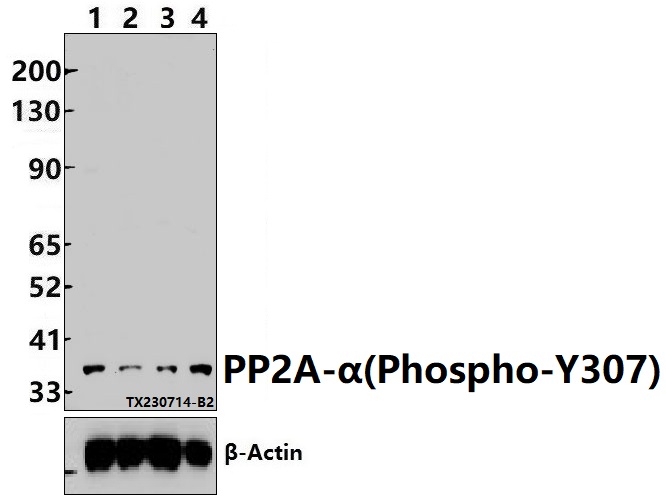Product Name :
PP2A-α (Phospho-Y307) polyclonal antibody Background :
Protein phosphatase type 2A (PP2A) is an essential protein serine/threonine phosphatase that is conserved in all eukaryotes. PP2A is a key enzyme within various signal transduction pathways as it regulates fundamental cellular activities such as DNA replication, transcription, translation, metabolism, cell cycle progression, cell division, apoptosis and development. The core enzyme consists of catalytic C and regulatory A (or PR65) subunits, with each subunit represented by α and β isoforms. Additional regulatory subunits belong to four different families of unrelated proteins. Both the B (or PR55) and B' regulatory protein families contain α, β, γ and δ isoforms, with the B' family also including an ε protein. B'' family proteins include PR72, PR130, PR59 and PR48 isoforms, while striatin (PR110) and SG2NA (PR93) are both members of the B''' regulatory protein family. These B subunits competitively bind to a shared binding site on the core A subunit. This variable array of holoenzyme components, particularly regulatory B subunits, allows PP2A to act in a diverse set of functions. PP2A function is regulated by expression, localization, holoenzyme composition and post-translational modification. Phosphorylation of PP2A at Tyr307 by Src occurs in response to EGF or insulin and results in a substantial reduction of PP2A activity. Reversible methylation on the carboxyl group of Leu309 of PP2A has been observed. Methylation alters the conformation of PP2A, as well as its localization and association with B regulatory subunits. Product :
Rabbit IgG, 1mg/ml in PBS with 0.02% sodium azide, 50% glycerol, pH7.2. Storage&Stability :
Store at 4°C short term. Aliquot and store at -20°C long term. Avoid freeze-thaw cycles. Specificity :
PP2A-α (Phospho-Y307) polyclonal antibody detects endogenous levels of PP2A-α protein only when phosphorylated at Tyr307. Immunogen :
Synthetic phosphopeptide derived from human PP2A-α around the phosphorylation site of Tyrosine 307. Conjugate :
Unconjugated Modification :
Phosphorylated
PP2A-α (Phospho-Y307) polyclonal antibody Background :
Protein phosphatase type 2A (PP2A) is an essential protein serine/threonine phosphatase that is conserved in all eukaryotes. PP2A is a key enzyme within various signal transduction pathways as it regulates fundamental cellular activities such as DNA replication, transcription, translation, metabolism, cell cycle progression, cell division, apoptosis and development. The core enzyme consists of catalytic C and regulatory A (or PR65) subunits, with each subunit represented by α and β isoforms. Additional regulatory subunits belong to four different families of unrelated proteins. Both the B (or PR55) and B' regulatory protein families contain α, β, γ and δ isoforms, with the B' family also including an ε protein. B'' family proteins include PR72, PR130, PR59 and PR48 isoforms, while striatin (PR110) and SG2NA (PR93) are both members of the B''' regulatory protein family. These B subunits competitively bind to a shared binding site on the core A subunit. This variable array of holoenzyme components, particularly regulatory B subunits, allows PP2A to act in a diverse set of functions. PP2A function is regulated by expression, localization, holoenzyme composition and post-translational modification. Phosphorylation of PP2A at Tyr307 by Src occurs in response to EGF or insulin and results in a substantial reduction of PP2A activity. Reversible methylation on the carboxyl group of Leu309 of PP2A has been observed. Methylation alters the conformation of PP2A, as well as its localization and association with B regulatory subunits. Product :
Rabbit IgG, 1mg/ml in PBS with 0.02% sodium azide, 50% glycerol, pH7.2. Storage&Stability :
Store at 4°C short term. Aliquot and store at -20°C long term. Avoid freeze-thaw cycles. Specificity :
PP2A-α (Phospho-Y307) polyclonal antibody detects endogenous levels of PP2A-α protein only when phosphorylated at Tyr307. Immunogen :
Synthetic phosphopeptide derived from human PP2A-α around the phosphorylation site of Tyrosine 307. Conjugate :
Unconjugated Modification :
Phosphorylated
-
 Western blot (WB) analysis of PP2A-α (Phospho-Y307) polyclonal antibody at 1:500 dilution Lane1:HEK293T whole cell lysate(30ug) Lane2:HEK293T treated with λ-phosphatase whole cell lysate(30ug) Lane3:3T3-L1 whole cell lysate(30ug) Lane4:PC12 whole cell lysate(30ug)
Western blot (WB) analysis of PP2A-α (Phospho-Y307) polyclonal antibody at 1:500 dilution Lane1:HEK293T whole cell lysate(30ug) Lane2:HEK293T treated with λ-phosphatase whole cell lysate(30ug) Lane3:3T3-L1 whole cell lysate(30ug) Lane4:PC12 whole cell lysate(30ug) -

C1q/tumor necrosis factor-related protein-3 enhances the contractility of cardiomyocyte by increasing calcium sensitivity
PMCID: Pubmed No.:28807153
CBP Bromodomain Inhibition Rescues Mice From Lethal Sepsis Through Blocking HMGB1-Mediated Inflammatory Responses
PMCID: Pubmed No.:33603756
Memantine Differentially Regulates Tau Phosphorylation Induced by Chronic Restraint Stress of Varying Duration in Mice
PMCID: Pubmed No.:30906318
Protein phosphatase 2A deficiency in hippocampal CA1 inhibits priming effect of morphine on conditioned place preference in mice
PMCID: Pubmed No.:36627245
Bioworld Biotech only provide peptides for our antibodies and do not provide additional peptide customization services.
Price/Size :
USD 368/1mg/vial
Tips:
For phospho antibody, we provide phospho peptide(0.5mg) and non-phospho peptide(0.5mg).Describe :
Blocking peptides are peptides that bind specifically to the target antibody and block antibody binding. These peptide usually contains the epitope recognized by the antibody. Antibodies bound to the blocking peptide no longer bind to the epitope on the target protein. This mechanism is useful when non-specific binding is an issue, for example, in Western blotting (WB) and Immunohistochemistry (IHC). By comparing the staining from the blocked antibody versus the antibody alone, one can see which staining is specific; Specific binding will be absent from the western blot or IHC performed with the neutralized antibody.Formula:
Synthetic peptide was lyophilized with 100% acetonitrile and is supplied as a powder. Reconstitute with 0.1 ml DI water for a final concentration of 10 mg/ml.The purity is >90%,tested by HPLC and MS.
Storage:
The freeze-dried powder is more stable. For short time at 2-8°C. For long term storage store at -20°C.
Note :
This product is for research use only (RUO only). Not for use in diagnostic or therapeutic procedures.
 PP2A-α (Phospho-Y307) polyclonal antibody
PP2A-α (Phospho-Y307) polyclonal antibody  Datasheet
Datasheet COA
COA MSDS
MSDS SHIP
SHIP